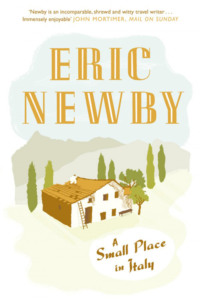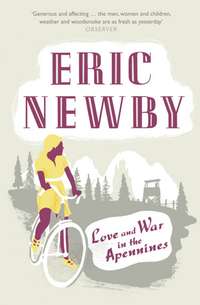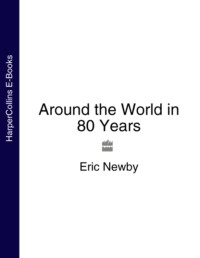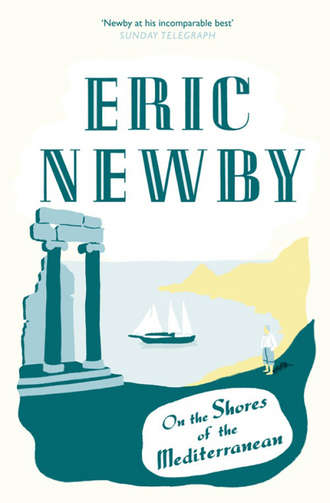
Полная версия
On the Shores of the Mediterranean

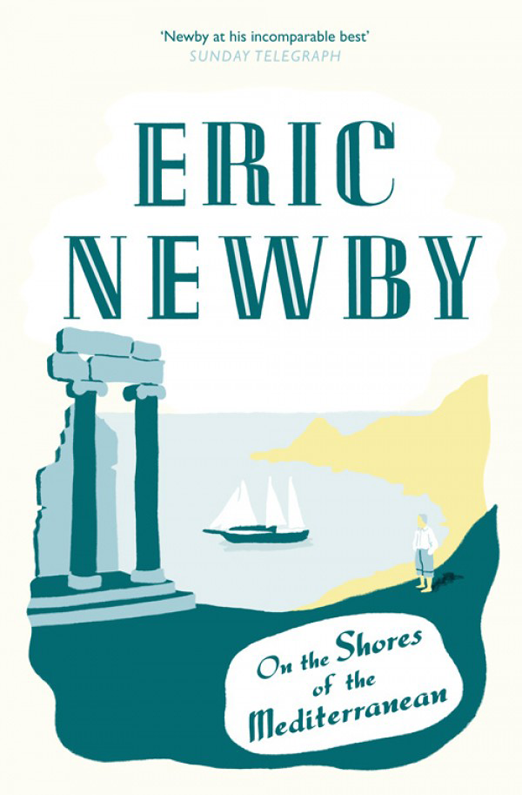
ERIC NEWBY
On the Shores of the Mediterranean

Dedication
To Wanda, the only item of essential equipment – apart from a Rolex watch (boiled in a stew by Afghans to test its waterproof qualities) – not lost, stolen or simply worn out in the course of some thirty years of travel together.
Contents
Cover
Title Page
Dedication
Map
I ITALY
A Tuscan Vineyard
In the Streets of Naples
An Evening in Venice
II THE ADRIATIC
On the Way to the Balkans
A Night in Montenegro
Albania Stern and Wild
III GREECE
Grecian Shores
In the Steps of Ali Pasha
Monasteries of the Air
The Ascent of Mount Olympus
IV TURKEY
A View of the Hellespont
Baths and Bazaars
The Harem at Topkapi
The Plain of Troy
An Encounter with Nomads
V THE LEVANT
Jerusalem
VI NORTH AFRICA
In and Out of a Pyramid
Return to Tobruk
Into a Minefield
Not Quite Leptis Magna
On the Edge of the Sahara
View from a Hill
VII RETURN TO EUROPE
Imperial Rock
Holy Week in Seville
Dinner at the Negresco
The Last Vintage
Bibliography
Index
Acknowledgements
About the Author
Praise
Also by the Author
Copyright
About the Publisher
Map
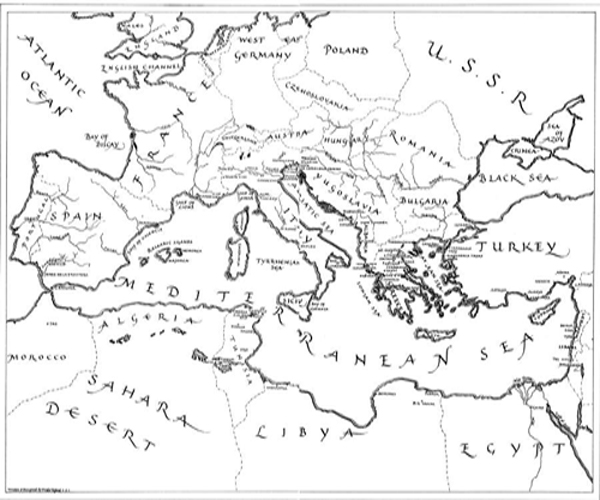
PART ONE ITALY

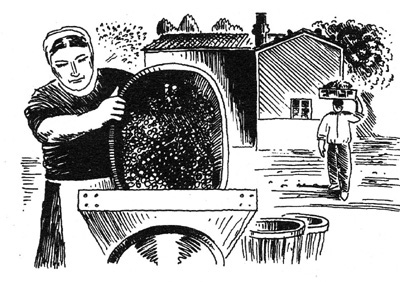
A Tuscan Vineyard
When people in England and America ask about our house in Italy and we tell them that it is in northern Tuscany, their eyes light up, because Tuscany is one of the parts of Italy that the British and the Americans know about, or think they do. For most of them who have visited it, Tuscany conjures up that rather open-cast country permanently suffused in golden light that forms the background of so many fourteenth-century paintings, country in which Chianti is made. In their mind’s eye they even think they know what sort of house it is we live in, though we stress the fact that it is very small and very ungrand. They immediately begin to think of the sort of house that appears with its name against it on a map, or in an architectural guide to Tuscany as a Villa, followed by the name of its past owner, often a hyphenated one, and that of its present owner, preceded by the word ora, meaning ‘now’; for example, to invent one, Villa Grünberg-Tiffany, ora Newby, a place with a spacious terrace and lots of statuary, the sort of place at which Sitwells used to, and Harold Acton still might, drop in uninvited to tea.
In fact our house is in a part of Tuscany so far to the north of Florence, Pisa and Lucca that it ceases to conjure up the idea of Tuscany at all, either in its countryside or in the quality of its light. It is quite near Carrara, a place famous for its marble, where Michelangelo had enormous blocks of the stuff quarried, as did later Henry Moore and Noguchi; marble that is still used to make the sort of tombstones that are popular with the Mafia and the Camorra, the other criminal secret society. Carrara, probably because of the abundance of blasting material conveniently to hand, is also the headquarters of the Italian Anarchists and the place where they hold, or used to until recently – nothing is for ever – their annual convention. The house certainly cannot be called a villa, or even a weekend villetta, let alone a Villa-whatever-it-was, ora Newby. Looking down on it from the upper part of our vineyard it resembles a dun, a prehistoric Irish fort, more than a dwelling, or else one of those enormous heaps of stone that people in limestone countries used to pile up in the process of making a field, before the coming of the bulldozer, which is what a lot of old peasant houses do look like in the Mediterranean lands. It does in fact appear as a small black blip on a sheet of the Italian 1:25,000 military maps, which look as if they had been drawn by a lot of centipedes with ink on their feet.
One of the reasons we had bought it was because it was exactly like almost any one of the various houses in which Italian peasants had hidden me high up in the Apennines in the winter of 1943–4 when I had been an escaped prisoner-of-war. It was in autumn 1943 that, emerging from my prison camp in the valley of the River Po, I had first met my wife, who lived in the nearby village and who had arranged for me, because I had a broken ankle, to be hidden in the maternity ward of the local hospital. Later, I had been recaptured and sent to Germany, but when I was finally released in 1945 I had gone back to Italy, and Wanda and I had subsequently married. And we still are married.
The house is in a little dell, and although it is hidden from almost every other point by the chestnuts, i castagni, from which it takes its name, and by olive trees and vineyards, it has a magnificent view over the valley in which the Magra, one of Italy’s polluted rivers, flows into the Ligurian Sea, one of the numerous more or less polluted seas into which the Mediterranean is sub-divided.
We found the keys, all five of them, where our neighbours had hidden them in case we arrived late at night, as like many of the older country people, they went to bed as soon as it was dark and they had eaten their evening meal, which was what most country people did before the arrival of television. Three of the keys are very big, all of them are very old and shiny. On the first day the house became ours some twenty years ago I lost one of the big ones, a key that had been made when the house was built more than a hundred years before, and I never found it again. Luckily there was a spare key, but that was the only one. The doors of the house are made of slabs of chestnut cut by hand, and they are so full of cracks and holes that from the inside you can see the light of day shining through them in dozens of places. When I lose the rest of the keys, or if the huge locks give up, it will mean new doors, and the house will never look the same again.
With the doors open I switched on the current and turned the water on at the tap outside the bathroom; the water comes from a spring higher up the hill called la Contessa and is very good. The bathroom is in what had been the stalla, the byre in which the animals were kept, on the ground floor below the hay loft, and this means that when we want to visit it in the night from our bedroom, which is upstairs, we have to go down the staircase which leads to it. The staircase is in the open air, which is why visitors are provided with chamber pots in which they occasionally put their feet when getting out of bed in the darkness, with spectacular results.
Apart from some dust and fallen plaster and a few dead mice, there was nothing much wrong. Here, the mice are almost as big as rats. This time they had eaten the poison laid down for them the previous winter instead of our bedding, as they often do, gnawing their way through the backs of old chests-of-drawers to get at it, although one or two of them had taken some chunks out of a red shirt of mine from L. L. Bean, Freeport, Maine, to make what we subsequently found when we discovered one of their nests, to be blankets for their children.
While I turned things on and buried dead mice, Wanda began to remove the plastic sheeting which protected the mattresses on the old iron bedsteads which are painted with flowers, some of them inlaid with mother-of-pearl, beds she had bought, or had simply been allowed to cart away, years ago, when the local farmers’ wives had decided to modernize their houses and had thrown them out to rust in their back yards.
Outside, in the vineyard on the side of the hill, the grapes looked healthy enough, having been sprayed with copper sulphate throughout the summer, and quite good, but not very numerous. It had been a very wet spring and had continued to be wet right into June, but what had then followed had been a phenomenally hot summer, even for Italy, with shade temperatures week after week up in the hundreds Fahrenheit, and absolutely no rain; and this weather had persisted into autumn, apart from a few short, welcome downpours. Down in central Tuscany, even as far north as Lucca, the grapes were abundant and it would be a good year. Here, where we lived, where often in early autumn it rained and rained when the sirocco blew from Africa, and the grapes then began to suffer from muffa, mildew, or a sudden hailstorm could destroy an entire crop in a few minutes, it was increasingly rare to have an outstanding year for what would never be, even if the grapes were outstanding, outstanding wines. Here, in an area which only appears on the most optimistic wine maps as being of moderate wine production, we and the neighbouring farmers make white and red wine, using as many varieties of grapes as possible, in our case about six, as a talisman principally against disease.
The end product is not what is known as DCG (Denominazione Controllata e Garantita), or DOC (Denominazione Origine Controllata), or even, until recently, DS (Denominazione Semplice), the humblest of all denominations, because in order to satisfy these minimal requirements, it would have to have a label stating the region in which it was produced, something I had never seen before 1983.
This wine can rarely, if ever, be found on sale even in local shops. When our neighbouring farmers sell what is surplus to their own enormous requirements, then it invariably finds its way into private houses or the sort of trattoria which announces its cooking as being cucina casalinga, the sort the best Italian mothers turn out every day for the whole of their working lives. This is because it fulfils the demand, which is becoming every year more difficult to satisfy, not only in Italy but in every other wine-producing country, for everyday drinking wine that has no additives, the sort of wine that has neither been pasteurized nor clarified with pills, although it is almost impossible to make white wine that can travel without any kind of help that will not change its colour. Wine that has been too generously assisted in this way, however, possibly with the addition of sodium bisulphate, looks like water, has a sickly aftertaste and gives the drinker a ferocious headache with its epicentre between the eyebrows.
The harvesting of the grapes, here where we live, hardly ever begins before the festa of San Remigio, which takes place on 1 October each year at Fosdinovo, a large village on the hill some nineteen hairpin bends above us. The stone effigy of San Remigio, the patron saint of the town, a saint who baptized Clovis, King of the Franks, stands high above the altar in one of the two churches. Also high up to one side of it is the tomb of one of the Malaspina family, feudal lords of this part of Italy, which is still called Lunigiana, after Luni, a Roman city and seaport now high and dry on what had been the northern borders of ancient Etruria. They still own and inhabit the castle which looms above the rooftops and in which Dante stayed.
For weeks before the festa there is bee-like activity everywhere and all the specialist shops along the terrible, traffic-ridden Via Aurelia, one of the great Roman roads to Rome, which sell barrels, hods, grape crushers and presses, have them prominently displayed outside their premises.
The actual festa begins to assemble itself early in the morning, long before dawn, when a procession of vans, lorries and motor cars starts groaning up the hill to the town loaded with merchandise which will later be displayed on the stalls in the open-air market place under the plane trees below the village. It is mostly cheap stuff, but some products of the pre-plastic age still persist: copper cauldrons, earthenware casseroles, mousetraps made of wood that look like lock-up garages, thick woollen socks and vests and the bed-warmers known as preti, priests, wooden frameworks which you put between the bedsheets on cold winter nights with an iron pot full of hot ashes inside them and which warm a bed in a way that no other kind of warmer can. Also on sale will be pack-mules, pigs and cattle. The animals are sold on the same patch of ground that has been used for this purpose as long as anyone can remember, although it has now been turned into a children’s playground and is full of plastic gnomes. And there is plenty to eat. In the market you can also buy panini, big, crusty sandwiches filled with delicious slices of pork cut from a young pig that has been roasted on a spit. And there is also plenty to drink. Until recently there were open-air drinking booths under the plane trees at which you could sit and eat panini and drink last year’s wine at tables with white cloths on them. Now, if you want to eat and drink you have to do it indoors because it is very rare, almost unknown, for it not to pour with rain on the festa of San Remigio. Last year was an exception. This is the day, too, when Wanda, and she did it for more than fifteen years, worked in one of the two hotels as a waitress, to help out with the farmers’ lunches, invariably receiving an offer of marriage from one of them who had become a widower in his fifties.
This year we have arrived too early for San Remigio, but not too early to harvest our grapes and make our wine, or help others with their vendemmia, the harvesting and the wine-making. We always help four families with the vendemmia. The harvesting of the grapes usually takes one or two days; the fermentation takes about ten days. To be asked to help is an honour because it means that we are regarded as hard workers, and therefore earn the prodigious quantities of wine and food that are served throughout the vendemmia.
It takes several days to get ready for our own vendemmia. All the barrels have first to be washed and scrubbed and then kept standing upright with a hose running water into them until the seams swell and close and they no longer leak. So on the first morning when the vendemmia begins we start work with the family which owns the farm across the road from where the track leads down to our house. We have known them ever since we first came here. Their children have come to England and stayed with us and we have seen them grow up, get married and themselves have children.
Tomorrow, around seven-thirty, dressed in our oldest clothes, we will turn up at the big modern farmhouse they have built to replace the old, more beautiful one, armed with baskets with iron hooks on them so that we can hang them from the pergole, the horizontal wires on which vines are trained, while we cut the grapes with scissors, secateurs, or just sharp knives, all of which become equally painful to handle when you use them day after day.
If the family is an efficient one, and this one is highly efficient, there should be about a dozen people waiting outside, and the tractor should be warmed up and the trailer attached to it, already filled with the heavy hods called bigonci, sometimes made of plastic now and much lighter, in which the grapes are brought back to the house and poured into the macchina da macinare, the grape crusher. If they are an inefficient lot and no one else has turned up, which often means they have forgotten to ask them, a lot of screaming across valleys to other houses takes place – ‘Maariaaa! Ahmaaandoh! Doveee seei?’ (‘Maria! Armando! Where are you?’) – just as they had screamed at one another across similar expanses up in the nearby Apennines when I was hiding from the Germans. Or they could still be scrubbing the barrels or even waiting for the barrel staves to swell sufficiently to stop the barrels leaking, which should have been done long before, or perhaps the man with the tractor hasn’t arrived, in any of which cases we hang about and get cheesed off. The most inefficient people we know are the P.… s, who are never ready. One year the bottom literally fell out of their biggest barrel, which was really enormous, after we had quarter filled it with crushed grapes. Yet in spite of being highly inefficient, they make some of the best wine in the district.
We always start at the most distant vineyard, which may be a mile or more away from the house, up or down the hillside, often separated from it by other people’s properties and usually only reached by the roughest and steepest of tracks.
In some of the vineyards the grapes are still trained on pergole, trellises, some of them extended out over steep banks which are anything up to eight feet high. Pergole are picturesque and shade you from the midday sun, but they no longer accord with modern wine-making theory. No more trellises are being constructed, and new vineyards are planted in regular, widely-spaced parallel rows in fields bulldozed out of the hillside, and the pretty terraced fields one above the other will soon be no more. It is difficult to cut the bunches of grapes under a pergola. If they are very high you have to use triangular, home-made step ladders, which everyone keeps for this purpose and for harvesting the olives later in the year, but often, when the ground underneath is too bumpy to set them up, I find myself swinging from the pergola, like one of the larger primates trying to reach some far-out bunches.
If it rains it is hell. If it rains heavily you have to stop work, because you get too much water with the grapes when you squash them in the press. A sack is the best thing to wear over the head and shoulders when it rains, cooler and less constricting than a waterproof. If the grapes are more or less a write-off, as they were in 1972, and it rains as well, it is indeed lugubrious, but whatever the conditions, the day passes in constant gossip, which seems to become more and more lubricious as the day goes on; some of the more hair-raising stories being recounted by respectable-looking ladies dressed in the deepest black. From time to time, gusts of laughter sweep through the vineyard as a result of some particularly coarse remark. Some of the time I don’t harvest the grapes. Instead I am given the job of heaving the bigonci, filled with grapes, on to the trailer which will take them back to the press. This is because I am one of the few grown men here who haven’t yet had a hernia from lifting enormous weights.
At about ten o’clock, after we have worked for a couple of hours or more, we have a merenda, a picnic, in whichever field we happen to be in, brought there by the farmer’s wife; a very un-English breakfast spread out on a white cloth on the grass, with lots of fresh pecorino, cheese made with ewe’s milk, prosciutto, and what is here called mortadella but which is nothing like real mortadella di Bologna – more like salami – bread baked in the outside wood oven which every house possesses, and wine. We go on having swigs of wine throughout the day, to keep us going, not much but enough, always white.
At about a quarter to one we go back to the house for the midday meal, by which time we have, temporarily at least, had enough. All the morning a band of women have been sorting the bunches that they take from the baskets at tables set up in the various fields, cutting off long stalks, removing leaves which would give the wine a bad taste and rejecting unripe grapes or those covered with mildew, before putting the rest into the bigonci. Sometimes, if it is hot, we eat at a long table outside in the yard, but usually we are in the parlour with great black and white photographs of ancestors on the walls. We never drink before the meal, apart from the occasional swig we have already had in the fields, and we never mix white with red, because drinking on an empty stomach and mixing white with red is thought to be injurious to health.
We eat brodo, broth, made with beef or chicken stock, with pasta in it, followed by manzo bollito, boiled beef, stuffed with a mixture of spinach, egg, parmigiano cheese and mortadella; and also roast or boiled chicken chopped up with a chopper and the bones broken, the chickens being the best sort that have scratched a living in the yard, roast potatoes, the bitter green salad called radici, mixed with home-produced olive oil and vinegar, and plates of delicious tomatoes eaten with oil, salt and pepper.
The afternoon seems longer and harder and, if it is hot, much hotter than the morning, and the work goes on in the fields until it is so dark that it is no longer possible to see anything. It goes on longer back at the house where there is usually a last trailer-load of bigonci full of grapes that have to be fed into the macchina da macinare, from which they fall into full ones which you hoist on your shoulder before staggering away with them and pouring the contents into one of the barili in which it will eventually become wine.
Now, after a good wash at a tap in the yard, we all sit down again, with the children home from school, to eat a dinner: a home-made ravioli (each house has a special piece of furniture called a madia, a sort of dough tray, for making pasta), more meat and chicken, but never for some reason pork, then cheese and lots of walnuts, with which we drink the stronger, sweeter wines of which the owner is usually very proud, and coffee.
Then we all reel home under the stars, or through wetting rain, sometimes, if we have indulged too freely, falling into ditches which some thoughtless fellows seem to have dug since we passed that way in the morning; and the next day will be the same, and the next.
This time, we had not come here only to make the wine or simply to drink it while at the same time enjoying the heat of the Mediterranean sun. This time, we were using I Castagni as the point of departure for other, some of them wilder, shores of the Mediterranean. Now it was August. This year, to do our vendemmia we would have to return from wherever we happened to be.
What we were hoping to do was to travel around the shores of the Mediterranean, or as many as we felt inclined to travel round (some of them being at that time – as they still are – either difficult or undesirable places to visit unless you have to), with the idea of seeing people, places and things that we had either never seen before or had not seen for so long that we both wanted to see them again and to discover – though we were less anxious about this – what changes time had wrought in them.




